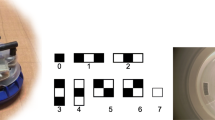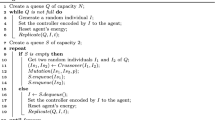Abstract
Recently, there has been a lot of interest in evolving controllers for both physically simulated creatures as well as for real physical robots. However, a range of different ANN architectures are used for controller evolution, and, in the majority of the work conducted, the choice of the architecture used is made arbitrarily. No fitness landscape analysis was provided for the underlying fitness landscape of the controller’s search space. As such, the literature remains largely inconclusive as to which ANN architecture provides the most efficient and effective space for searching the range of possible controllers through evolutionary methods. This represents the motivation for this paper where we compare the search space for four different types of ANN architecture for controller evolution through an information-theoretic analysis of the fitness landscape associated with each type of architecture.








Similar content being viewed by others
References
Adami C (1998) Introduction to artificial life. Telos Publishing, Santa Clara, CA
Bongard JC (2002) Evolved sensor fusion and dissociation in an embodied agent. In: Proceedings of the EPSRC/BBSRC International Workshop on Biologically-Inspired Robotics: The Legacy of W. Grey Walter, pages 102–109, Bristol, UK
Bongard JC, Paul C (2001) Making evolution an offer it can’t refuse: morphology and the extradimensional bypass. In: Keleman J, Sosik E (eds) Advances in artificial life: Proceedings of the 6th European Conference on Artifıcial Life (ECAL01), Springer, Berlin Heidelberg New York
Bongard JC, Pfeifer R (2002) A method for isolating morphological effects on evolved behavior. In: Hallam B, Floreano D, Hayes G, Hallam J, Meyer J-A (eds) From animals to animats 7: Proceedings of the Seventh International Conference on the Simulation of Adaptive Behavior (SAB2002), MIT Press, Cambridge, MA
CM Labs (2002) http://www.cm-labs.com. Cited 25 January 2002
Elman JL (1990) Finding structure in time. Cog Sci 14(3):179–211
Floreano D, Mondada F (1998) Evolutionary neurocontrollers for autonomous mobile robots. Neur Netw 11:1461–1478
Floreano D, Urzelai J (1998) Evolution and learning in autonomous mobile robots. In: Mange D, Tomassini M (eds) Bio-Inspired computing machines: towards novel computational architectures, Presses Polytechniques Et Universitaires Romandes, Lausanne, Switzerland
Floreano D, Urzelai J (2000) Evolutionary robotics: the next generation. In: Gomi T (ed) Proceedings of the 7th International Symposium on Evolutionary Robotics: From Intelligent Robots to Artificial Life (ER2000), AAI Books, Ontario, Canada
Grimek B (1984) Grimek’s animal life encyclopedia. In: Insects, vol. 2, Van Nostrand Reinhold, New York
Husbands P, Harvey I, Jakobi N, Thompson A, Cliff D (1997) Evolutionary robotics. In: Back T, Fogel DB, Michalewicz Z (eds) Handbook of evolutionary computation, Institute of Physics Publishing, Bristol, PA
Ijspeert AJ (2000) A 3-D biomechanical model of the salamander. In: Heudin JC (ed) Proceedings of the 2nd International Conference on Virtual Worlds (VW 2000), Springer, Berlin Heidelberg New York
Jakobi N (1998) Running across the reality gap: octopod locomotion evolved in a minimal simulation. In: Husbands P, Meyer J-A (eds) Proceedings of the First European Workshop on Evolutionary Robotics, Springer, Berlin Heidelberg New York
Kauffman SA (1993) The origins of order. Oxford University Press, New York
Komosinski M (2000) The world of framsticks: aimulation, evolution, interaction. In: Heudin JC (ed) Proceedings of the 2nd International Conference on Virtual Worlds, Springer, Berlin Heidelberg New York
Lund HH, Hallam J (1997) Evolving sufficient robot controllers. In: Proceedings of the 4th IEEE International Conference on Evolutionary Computation, IEEE Press, Piscataway, NJ
Nolfi S (2002) Power and limits of reactive agents. Neurocomp 42:119–145
Nolfi S, Floreano D (1999) Learning and evolution. Auton Robot 7(1):89– 113
Nolfi S, Floreano D (2002) Synthesis of autonomous robots through evolution. Trend Cog Sci 6(1):31–36
Otsu K, Ishiguro A, Fujii A, Aoki T, Eggenberger P (2001) Evolving an adaptive controller for a quadruped-robot with dynamically-rearranging neural networks. In: Proceedings of the IEEE/RSJ International Conference on Intelligent Robots and Systems (IROS2001), IEEE Press, Piscataway, NJ
Paul C, Bongard JC (2001) The road less travelled: morphology in the optimization of biped robot locomotion. In: Proceedings of the IEEE/RSJ International Conference on Intelligent Robots and Systems (IROS2001), IEEE Press, Piscataway, NJ
Reeve R (1999) Generating walking behaviors in legged robots. Dissertation, University of Edinburgh
Reil T, Husbands P (2002) Evolution of central pattern generators for bipedal walking in a real-time physics environment. IEEE Trans Evol Comp 6(3):159–168
Reil T, Massey C (2001) Biologically inspired control of physically simulated bipeds. Theor Biosci 120(3–4):327–339
Shannon CE (1948) A mathematical theory of communication. Bell Sys Tech J 27(3):379–423
Sims K (1994) Evolving 3D morphology and behavior by competition. In: Brooks R, Maes P (eds) Artificial Life IV: Proceedings of the Fourth International Workshop on the Synthesis and Simulation of Living Systems, MIT Press, Cambridge, MA
Smith T, Husbands P, Layzell P, O’Shea M (2002) Fitness landscapes and evolvability. Evol Comp 10(1):1–34, 2002
Taylor T, Massey C (2001) Recent developments in the evolution of morphologies and controllers for physically simulated creatures. Artific Life 7(1):77–87
Vassilev VK, Fogarty TC, Miller JF (2000) Information characteristics and the structure of landscapes. Evol Comp 8(1):31–60
Wright S (1932) The roles of mutation, inbreeding, crossbreeding and selection in evolution. In: Jones DF (ed) Proceedings of the Sixth International Conference on Genetics Brooklyn, NY
Acknowledgements
This work was conducted entirely at the School of Computer Science, UNSW@ADFA, where the first author was conducting his doctoral research.
Author information
Authors and Affiliations
Corresponding author
Rights and permissions
About this article
Cite this article
Teo, J., Abbass, H.A. An information-theoretic landscape analysis of neuro-controlled embodied organisms. Neural Comput & Applic 13, 80–89 (2004). https://doi.org/10.1007/s00521-003-0395-7
Received:
Accepted:
Published:
Issue Date:
DOI: https://doi.org/10.1007/s00521-003-0395-7




